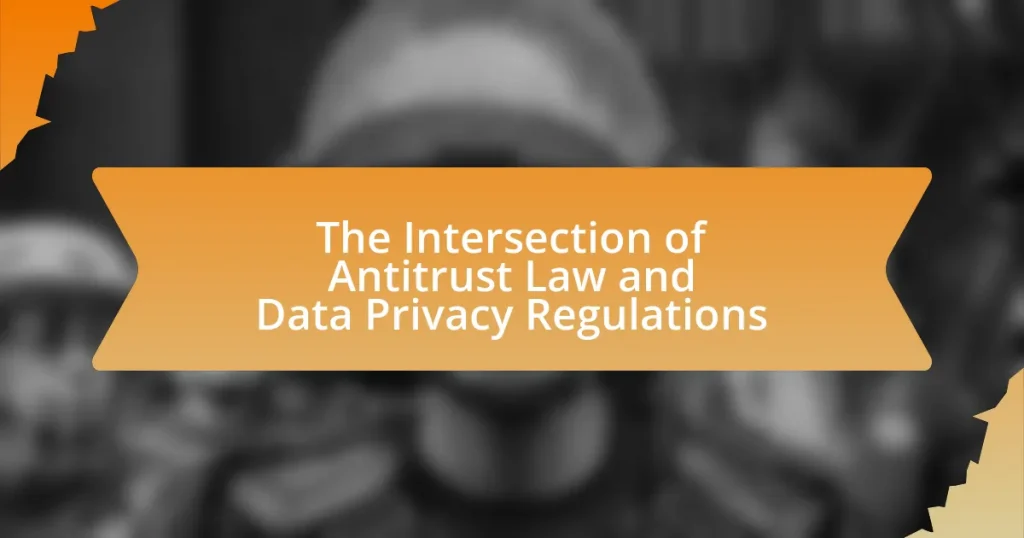Big Tech companies, including Google, Amazon, and Facebook, are significantly challenging traditional antitrust frameworks due to their vast market power, extensive data collection, and innovative technologies. These companies create barriers to entry for smaller competitors and raise concerns about consumer harm and market competition, as exemplified by the U.S. Department of Justice’s antitrust lawsuit against Google. The article explores the unique characteristics of Big Tech, the inadequacies of existing antitrust laws, and the implications of market concentration on competition and consumer choice. It also discusses proposed regulatory strategies and international perspectives aimed at reshaping the competitive landscape in response to the dominance of these tech giants.

How is Big Tech Challenging Traditional Antitrust Frameworks?
Big Tech is challenging traditional antitrust frameworks by leveraging their vast market power and network effects, which complicate the application of existing antitrust laws. Companies like Google, Amazon, and Facebook dominate their respective markets, creating barriers to entry for smaller competitors and raising questions about consumer harm and market competition. For instance, the U.S. Department of Justice’s antitrust lawsuit against Google in 2020 highlighted concerns over its search engine monopoly, arguing that it stifles competition and innovation. This case exemplifies how traditional antitrust frameworks, which often focus on price and consumer welfare, struggle to address the complexities of digital markets where data control and platform ecosystems play critical roles.
What are the key characteristics of Big Tech companies?
Big Tech companies are characterized by their vast market power, extensive data collection, and innovative technology. These companies, such as Google, Amazon, Facebook, and Apple, dominate their respective markets, often controlling significant shares that can exceed 40% in some sectors. Their ability to collect and analyze large amounts of user data enables them to personalize services and target advertising effectively, which enhances their competitive edge. Furthermore, their continuous investment in research and development leads to rapid technological advancements, allowing them to innovate and expand into new markets. For instance, Amazon’s diversification into cloud computing with Amazon Web Services has transformed it into a leader in that sector as well. These characteristics collectively challenge traditional antitrust frameworks, which struggle to address the unique dynamics of digital markets.
How do these characteristics differ from traditional industries?
Big Tech characteristics differ from traditional industries primarily in their scale, speed of innovation, and network effects. Unlike traditional industries, which often rely on physical assets and slower growth, Big Tech companies leverage digital platforms to achieve rapid scalability and global reach. For instance, companies like Amazon and Google can expand their user base exponentially without the proportional increase in costs associated with physical infrastructure, a phenomenon not typically seen in traditional sectors such as manufacturing or retail. Additionally, network effects in Big Tech mean that the value of a service increases as more people use it, creating significant barriers to entry for potential competitors, which contrasts with traditional industries where competition is often based on product differentiation and market share.
What role does data play in the business models of Big Tech?
Data is central to the business models of Big Tech, serving as a key asset that drives revenue generation and competitive advantage. Companies like Google and Facebook leverage vast amounts of user data to create targeted advertising, which accounted for over 80% of their total revenue in recent years. This data enables personalized user experiences, enhances product offerings, and informs strategic decisions, thereby solidifying market dominance. Furthermore, the collection and analysis of data allow these companies to innovate continuously, adapt to consumer preferences, and optimize operational efficiencies, reinforcing their positions in the market.
Why are traditional antitrust frameworks becoming inadequate?
Traditional antitrust frameworks are becoming inadequate due to their inability to address the complexities of digital markets dominated by Big Tech companies. These frameworks, originally designed for industrial economies, focus on price-fixing and market share, which do not capture the nuances of data-driven business models and network effects prevalent in the tech sector. For instance, the market power of companies like Google and Facebook is derived not just from their market share but from their control over vast amounts of user data and their ability to leverage that data for competitive advantage. This shift necessitates a reevaluation of antitrust laws to incorporate considerations of consumer welfare beyond price, including privacy, innovation, and market entry barriers.
What limitations exist within current antitrust laws?
Current antitrust laws face limitations in addressing the complexities of digital markets dominated by Big Tech companies. These laws often rely on outdated economic models that focus primarily on price effects, neglecting non-price factors such as data control, market power, and consumer privacy. For instance, the Sherman Act and the Clayton Act, established in the early 20th century, do not adequately account for the unique characteristics of digital platforms, such as network effects and the role of user data in competition. Additionally, enforcement mechanisms are often slow and reactive, making it difficult to address anti-competitive behaviors in real-time. This has led to a growing consensus among legal scholars and policymakers that existing frameworks need reform to effectively regulate the rapidly evolving tech landscape.
How do these limitations affect enforcement against Big Tech?
Limitations in regulatory frameworks hinder effective enforcement against Big Tech by creating gaps in accountability and oversight. For instance, existing antitrust laws often struggle to address the unique market dynamics and data monopolies that characterize Big Tech companies, leading to insufficient penalties for anti-competitive behavior. Additionally, the rapid pace of technological innovation outstrips the ability of regulators to adapt, resulting in outdated legal interpretations that fail to capture the complexities of digital markets. This has been evidenced by the slow progress in significant antitrust cases, such as the U.S. Department of Justice’s lawsuit against Google in 2020, which highlighted the challenges of proving anti-competitive practices in a landscape dominated by network effects and data control. Consequently, these limitations allow Big Tech firms to operate with a degree of impunity, undermining the effectiveness of enforcement efforts.
What are the implications of Big Tech’s dominance on competition?
Big Tech’s dominance significantly reduces competition by creating barriers to entry for smaller firms. This market concentration allows major companies like Google, Amazon, and Facebook to leverage their vast resources and data to outcompete emerging startups, often leading to monopolistic practices. For instance, a report by the House Judiciary Committee in 2020 highlighted that Amazon’s market power enables it to dictate terms to third-party sellers, stifling competition and innovation. Additionally, the dominance of these firms can lead to reduced consumer choice and higher prices, as seen in the digital advertising market where Google controls over 30% of the global share. Thus, Big Tech’s market position poses serious challenges to traditional antitrust frameworks designed to promote fair competition.
How does market concentration impact consumer choice?
Market concentration significantly limits consumer choice by reducing the number of available alternatives. In highly concentrated markets, a few firms dominate, leading to less competition and fewer options for consumers. For instance, in the technology sector, companies like Google and Amazon control substantial market shares, which can stifle innovation and restrict the diversity of products and services offered. Research from the American Economic Association indicates that increased market concentration correlates with higher prices and reduced product variety, demonstrating that consumers face fewer choices and potentially higher costs in such environments.
What are the potential risks of monopolistic practices by Big Tech?
Monopolistic practices by Big Tech pose significant risks, including reduced competition, stifled innovation, and consumer harm. When a few dominant companies control large market shares, they can manipulate prices, limit choices, and create barriers for new entrants. For instance, in 2020, the U.S. Department of Justice filed an antitrust lawsuit against Google, alleging that its practices harmed competition in the online advertising market, which could lead to higher prices for advertisers and consumers. Additionally, monopolistic behavior can result in data privacy concerns, as companies may prioritize profit over user protection, exemplified by Facebook’s Cambridge Analytica scandal, where user data was misused without consent. These risks highlight the need for updated regulatory frameworks to address the evolving challenges posed by Big Tech monopolies.

What strategies are being proposed to address these challenges?
Proposed strategies to address the challenges posed by Big Tech to traditional antitrust frameworks include enhancing regulatory oversight, implementing stricter data privacy laws, and promoting competition through the breakup of monopolistic practices. Regulatory bodies are advocating for increased scrutiny of mergers and acquisitions in the tech sector to prevent anti-competitive behavior. For instance, the European Union has introduced the Digital Markets Act, which aims to ensure fair competition by imposing obligations on major tech platforms. Additionally, lawmakers are considering legislation that would limit the data collection practices of these companies, thereby reducing their market power. These strategies are supported by evidence indicating that increased competition can lead to better consumer outcomes and innovation.
How are policymakers responding to the challenges posed by Big Tech?
Policymakers are implementing regulatory frameworks and legislative measures to address the challenges posed by Big Tech. For instance, the European Union has introduced the Digital Markets Act, which aims to prevent anti-competitive practices by large tech companies, ensuring fair competition and consumer protection. In the United States, lawmakers are proposing antitrust bills targeting monopolistic behaviors, such as the American Innovation and Choice Online Act, which seeks to prohibit dominant platforms from favoring their own products over competitors. These actions reflect a growing recognition of the need to adapt existing antitrust laws to the unique dynamics of the digital economy, as evidenced by increasing bipartisan support for regulatory reforms aimed at curbing the power of major tech firms.
What new regulations are being considered or implemented?
New regulations being considered include the European Union’s Digital Markets Act (DMA) and the Digital Services Act (DSA), aimed at increasing competition and accountability among large technology companies. The DMA targets gatekeeper platforms, imposing obligations to ensure fair competition, while the DSA focuses on content moderation and user safety online. These regulations are part of a broader effort to adapt antitrust frameworks to the unique challenges posed by Big Tech, as evidenced by ongoing discussions in various jurisdictions about the need for updated legal standards to address market dominance and consumer protection.
How do these regulations aim to reshape the competitive landscape?
These regulations aim to reshape the competitive landscape by imposing stricter guidelines on market behavior and promoting fair competition among technology companies. By targeting monopolistic practices and enhancing transparency, these regulations seek to prevent anti-competitive mergers and acquisitions, thereby fostering a more diverse marketplace. For instance, the European Union’s Digital Markets Act establishes clear rules for large tech firms, mandating that they allow interoperability with smaller competitors, which directly counters the dominance of established players. This regulatory approach is designed to level the playing field, encouraging innovation and consumer choice while reducing the market power of a few dominant firms.
What role do international perspectives play in antitrust discussions?
International perspectives significantly influence antitrust discussions by introducing diverse regulatory approaches and enforcement strategies. Different countries have varying definitions of anti-competitive behavior, which can lead to conflicting regulations, as seen in the European Union’s stringent data privacy laws compared to the more lenient U.S. framework. This divergence necessitates multinational corporations, particularly in the tech sector, to navigate a complex landscape of compliance, impacting their operational strategies and market behavior. For instance, the EU’s General Data Protection Regulation (GDPR) has prompted global companies to reassess their data practices, illustrating how international norms shape domestic antitrust considerations.
How do different countries approach Big Tech regulation?
Different countries approach Big Tech regulation through varying frameworks and strategies tailored to their specific economic and political contexts. For instance, the European Union has implemented the General Data Protection Regulation (GDPR) and the Digital Markets Act (DMA), which impose strict data privacy standards and promote competition by targeting monopolistic practices. In contrast, the United States has historically favored a more laissez-faire approach, focusing on antitrust lawsuits against major tech companies, such as the Federal Trade Commission’s case against Facebook in 2020, which aimed to break up its acquisitions of Instagram and WhatsApp. Meanwhile, China employs a more centralized regulatory approach, exemplified by its Cybersecurity Law and recent antitrust actions against companies like Alibaba, emphasizing state control and data security. These diverse regulatory approaches reflect each country’s priorities in balancing innovation, consumer protection, and market competition.
What lessons can be learned from international antitrust cases?
International antitrust cases reveal critical lessons about the need for adaptive regulatory frameworks to address the complexities of digital markets. These cases demonstrate that traditional antitrust principles may not adequately capture the nuances of market power held by Big Tech companies, as seen in the European Union’s actions against Google for anti-competitive practices, which resulted in fines exceeding €8 billion. Furthermore, international collaboration among regulators is essential, as evidenced by the coordinated investigations into Facebook’s data practices across multiple jurisdictions, highlighting the importance of a unified approach to effectively tackle cross-border antitrust issues. Lastly, these cases underscore the necessity for ongoing monitoring and flexibility in regulations to keep pace with rapid technological advancements and evolving business models.

What are the future prospects for antitrust frameworks in the age of Big Tech?
The future prospects for antitrust frameworks in the age of Big Tech involve significant reforms aimed at addressing the unique challenges posed by large technology companies. As these companies dominate markets and influence consumer behavior, regulators are increasingly considering new approaches, such as the implementation of ex-ante regulations that proactively prevent anti-competitive practices, rather than relying solely on traditional ex-post enforcement actions. For instance, the European Union’s Digital Markets Act, which aims to ensure fair competition by imposing obligations on major platforms, exemplifies this shift. Additionally, ongoing discussions in the United States about updating antitrust laws to better reflect the digital economy indicate a growing recognition of the need for adaptive regulatory frameworks. These developments suggest that future antitrust policies will likely focus on promoting competition, enhancing consumer protection, and ensuring market fairness in the rapidly evolving tech landscape.
How might antitrust laws evolve to better address Big Tech issues?
Antitrust laws may evolve to better address Big Tech issues by incorporating a more dynamic approach that considers market power and consumer harm in digital ecosystems. Current antitrust frameworks often focus on price effects and traditional market definitions, which may not adequately capture the complexities of digital platforms that leverage data and network effects. For instance, the European Union’s Digital Markets Act aims to establish clear rules for large online platforms, promoting competition by preventing anti-competitive practices such as self-preferencing and data monopolization. This legislative shift reflects a growing recognition that traditional antitrust measures need to adapt to the unique characteristics of digital markets, where user data and platform interconnectivity play critical roles in determining market dominance.
What innovative approaches could be adopted in antitrust enforcement?
Innovative approaches in antitrust enforcement could include the use of data-driven algorithms to analyze market dynamics and consumer behavior. These algorithms can identify anti-competitive practices more efficiently than traditional methods, allowing regulators to respond swiftly to emerging threats. For instance, the European Commission has begun employing advanced analytics to assess mergers and acquisitions in the tech sector, which helps in understanding the potential impact on competition. Additionally, implementing a proactive regulatory framework that emphasizes ongoing monitoring of market conditions can help prevent monopolistic behaviors before they become entrenched. This approach is supported by the increasing complexity of digital markets, where rapid innovation can outpace existing regulations.
How can collaboration between countries enhance antitrust efforts?
Collaboration between countries can enhance antitrust efforts by enabling the sharing of information, resources, and best practices to address anti-competitive behaviors that transcend national borders. For instance, joint investigations into multinational corporations can lead to more effective enforcement actions, as seen in the European Union’s collaboration with the U.S. Department of Justice in cases involving major tech companies. This cooperation allows for a unified approach to tackling issues like market dominance and anti-competitive mergers, which are increasingly relevant in the globalized digital economy. Furthermore, harmonizing regulatory standards across jurisdictions can reduce loopholes that companies might exploit to evade scrutiny, thereby strengthening overall antitrust enforcement.
What can businesses and consumers do in response to Big Tech’s influence?
Businesses can adopt alternative platforms and promote competition by supporting smaller tech companies, while consumers can exercise their purchasing power by choosing products and services from companies that prioritize privacy and ethical practices. For instance, businesses can shift to using open-source software or decentralized technologies, which can reduce reliance on major tech firms. Consumers can also advocate for stronger regulations and transparency in data usage, as seen in movements that support privacy legislation like the General Data Protection Regulation (GDPR) in Europe. These actions collectively challenge Big Tech’s dominance and encourage a more competitive market landscape.
What strategies can consumers employ to protect their interests?
Consumers can protect their interests by staying informed about their rights and the practices of big tech companies. This includes understanding data privacy policies, utilizing privacy settings on platforms, and being aware of consumer protection laws that apply to digital services. For instance, the General Data Protection Regulation (GDPR) in Europe empowers consumers to control their personal data, allowing them to request data deletion and access. Additionally, consumers can engage in collective actions, such as joining advocacy groups that challenge unfair practices and promote regulatory reforms. Research indicates that informed consumers are more likely to make choices that hold companies accountable, thereby influencing market behavior and encouraging compliance with fair practices.
How can businesses adapt to the changing regulatory environment?
Businesses can adapt to the changing regulatory environment by implementing proactive compliance strategies and engaging in continuous monitoring of regulatory developments. This involves establishing dedicated teams to analyze new regulations, conducting regular risk assessments, and ensuring that internal policies align with legal requirements. For instance, companies like Google and Facebook have invested in compliance departments to navigate evolving antitrust laws and data privacy regulations, demonstrating the importance of adapting to regulatory changes. By fostering a culture of compliance and utilizing technology for real-time monitoring, businesses can effectively mitigate risks associated with regulatory shifts.



